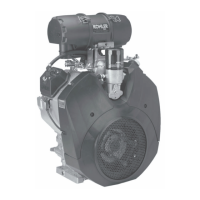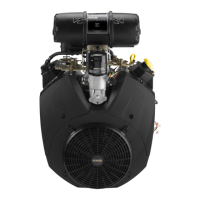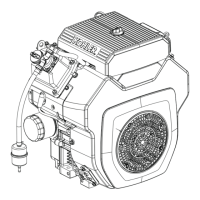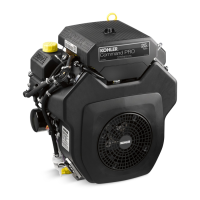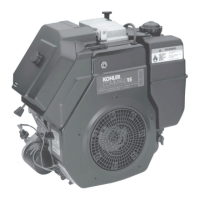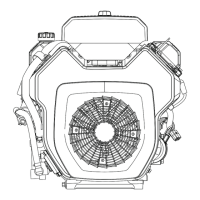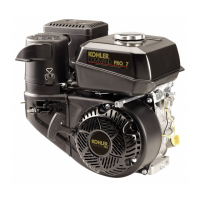Troubleshooting
18 62 690 01 Rev. CKohlerEngines.com
No Crankcase Vacuum/Pressure in Crankcase
Possible Cause Solution
1. Crankcase breather clogged or inoperative. NOTE: Replace valve cover and recheck pressure.
Breather is integral part of valve cover and
cannot be serviced separately.
1. Disassemble breather, clean parts thoroughly, check
sealing surfaces for fl atness, reassemble, and
recheck pressure.
2. Seals and/or gaskets leaking. Loose or improperly
torque fasteners.
2. Replace all worn or damages deals and gaskets.
Make sure all fasteners are tightened securely. Use
appropriate torque valves and sequences when
necessary.
3. Piston blowby or leaky valves (confi rm by inspecting
components).
3. Recondition piston, rings, cylinder bore, valves and
valves guides.
4. Restricted exhaust. 4. Check exhaust screen/spark arrestor (if equipped).
Clean or replace as needed. Repair or replace any
other damaged/restricted muffl er or exhaust system
parts.
Basic Engine Tests
A partial vacuum should be present in crankcase when engine is operating. Pressure in crankcase (normally caused
by a clogged or improperly assembled breather) can cause oil to be forced out at oil seals, gaskets, or other available
spots.
Crankcase vacuum is best measured with either a water manometer or a vacuum gauge. Complete instructions are
provided in kits.
To test crankcase vacuum with manometer:
1. Insert rubber stopper into oil fi ll hole. Be sure pinch
clamp is installed on hose and use tapered adapters
to connect hose between stopper and one of
manometer tubes. Leave other tube open to
atmosphere. Check that water level in manometer is
at 0 line. Make sure pinch clamp is closed.
2. Start engine and run no-load high speed.
3. Open clamp and note water level in tube.
Level in engine side should be a minimum of 10.2
cm (4 in.) above level in open side.
If level in engine side is less than specifi ed (low/no
vacuum), or level in engine side is lower than level in
open side (pressure), check for conditions in table
below.
4. Close pinch clamp before stopping engine.
To test crankcase vacuum with Vacuum/Pressure Gauge
Kit:
1. Remove dipstick or oil fi ll plug/cap.
2. Install adapter into oil fi ll//dipstick tube opening,
upside down over end of a small diameter dipstick
tube, or directly into engine if a tube is not used.
Insert barbed gauge fi tting into hole in stopper.
3. Run engine, as in step 2, and observe gauge
reading. Analog tester -needle movement to left of 0
is a vacuum, and movement to right indicates a
pressure.
Digital tester – depress test button on top of tester.
Crankcase vacuum should be a minimum of 10.2 cm
(4 in.) of water. If reading is below specifi cation, or if
pressure is present, check table below for possible
causes and remedies.
